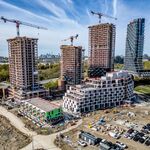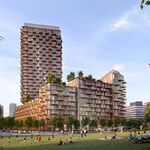There hasn't been a new neighbourhood built in the last twenty years in the GTA that wasn't much more walkable that those built in the 1980's.
It's at least as hilarious you dismiss what's changed since then.
Yes, a lot has changed indeed!
Huge, high speed arterial roads continue to be built
Houses either turn their backs to the street...
...or have roads next to roads.
This is where you do your shopping.
This is a drive through bank. Because you can't even deposit a freaking cheque without taking the car. While Toronto is developing many of their suburban plazas and strip malls (like Humbertown, Shops at Don Mills, Parkwoods Village, or any mixed use condo site), Brampton and others are building new ones exactly the same way as in the past.
Bus routes have to be gerrymandered in weird ways to attempt to reach everybody.
So much for mixed use. It's either pure residential, pure employment, or big box retail. You need a car to get between these different areas.
New business parks are being built farther away than ever before. See that scar east of Woodbine? I had to go there once for a job interview at a York Region municipal office. Getting there by transit was impossible. I brought my bike with me to the nearest bus stop (around Leslie & Davis), and biked the rest of the way. Not a single sidewalk or bike lane was to be found. We hear a lot from York Region about sustainability these days, but not only are they building more business parks with no shit given to non-motorists, but they even put their own offices there.
Milton is no better. Nothing is at a human scale. You'd think they could learn from Mississauga how not to build cities, but nope they want to apply the same discredited suburban planning principles.
But other than that, new neighbourhoods these days are so much more walkable than before, as exemplified by their stellar walk score...
...which have come a long way from old suburbia like North Scarborough. Oh wait, they haven't.
I'm not saying that new subdivisions should be like the Annex, but why not like Avenue Road? People can still have their mcmansions, but how about they face the street instead of turning their backs to it. How about cutting down on the disgusting amount of traffic lanes. Some main street retail like at Avenue & Lawrence would be great too, but apparently that's completely impossible to replicate in the 905.
How about having non-industrial employment along key roads right up to the sidewalk, instead of only in business parks. Surface parking can be at the back, or underground.
How about plazas that face the sidewalk, with their parking lot at the back instead. This one is under construction near Bayview & Eglinton.
How about having proper bus stops like the TTC, with a roof, bench, bus maps, route numbers, and concrete surface instead of this crap. This is where I recently waited 25 minutes on a really cold windy night. Later I got off the bus through the back door at a stop similar to this, and stepped in thick mud up to my ankle. Screw you Brampton and Mississauga transit.
Sorry, but suburbia today has never been more hostile for pedestrians. The only real difference I see is that new subdivisions are required to have a bit more density. You might even see an occasional bike lane if you're lucky. There's a lot of hype about Mt Pleasant or Cornell (which are only partially successful), but everything else being built is just plain ordinary business as usual.



















